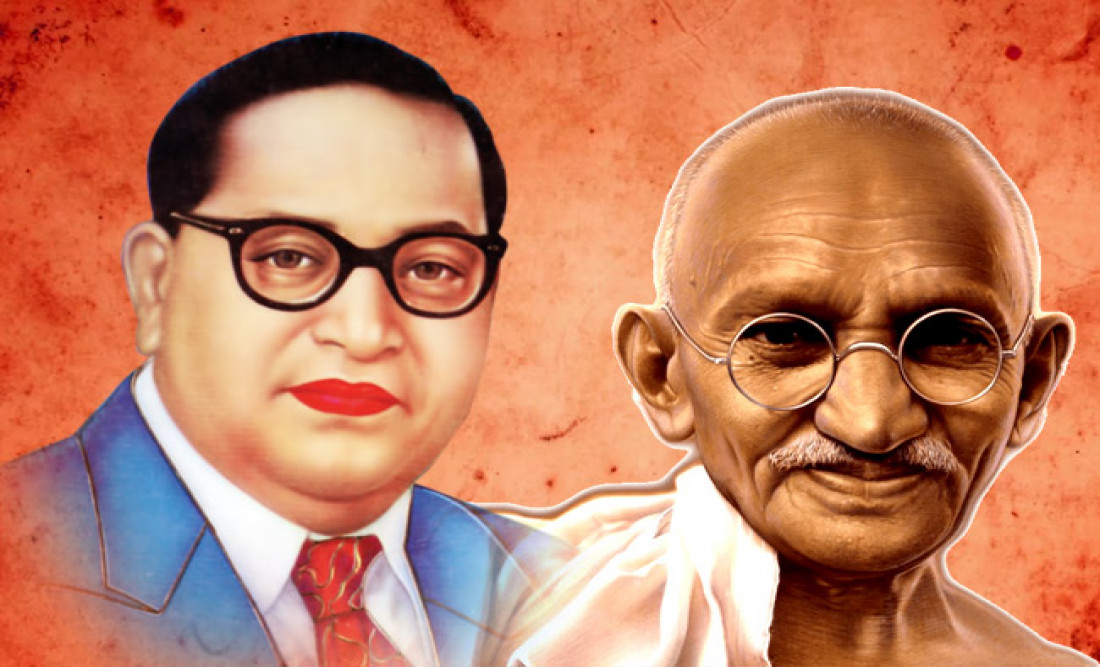Continuing quarrel between Gandhi and Ambedkar over two separate interviews on nation-building

Mahatma Gandhi and Dr. Ambedkar are among the great and influential figures of the twentieth century. They were a separate generation. Gandhi was born on October 2, 1869, and Ambedkar, on April 14, 1891. Heralal, the eldest son of Gandhi, was born on August 23, 1888. Thus, Ambedkar was 22 years younger than Gandhi and three years younger than Gandhi's eldest son. But both Gandhi and Ambedkar entered the Indian political scene around the same time. Gandhi returned to Bombay from South Africa in 1915. He wanted to educate his children in India and practice law. Gandhi made his public debut in India in February 1916, when he addressed a group of Indian nationalists and princely states at an event at the Kashi Hindu University, Varanasi. It was clear that he intended to go into politics. Dr. Ambedkar read his paper at the Humanities Symposium at Columbia University, USA, on May 9, 1916. This was the first time he had spoken from a public platform. From the contents, tone, and content of his speech, it was clear that he planned to join the active politics in India.
The speeches of both great men left their audiences astonished and shocked. In his speech, Gandhi brutally criticized the Swaraj movement while Ambedkar presented the world's intellectuals with bitter and horrific truths about India's social class. The years and decades that followed saw a clash between Gandhi's thinking and Ambedkar. They had different visions of rebuilding India. They had contradictory views. For Gandhi, the rebuilding of India involved the consolidation of the values of Vedic culture. Ambedkar wanted to lay the foundation for a new India based on modern Western values and linking them to the values of Buddhist civilization. Even today, Indian politics revolves around a struggle between these two worldviews. The statesman had different goals. Since their goals were different, their means were bound to be different.
Gandhi wrote three books in his life - Hind Swaraj in 1908, My Experiences with Truth in 1929, and The Key to Health in 1948. Hind Swaraj outlines Gandhi's political views. He also shared his opinions in his speeches and articles in various magazines and newspapers. Although Gandhi himself wrote only three books, thousands of books have been written about him and are still being written. There are over 1000 Gandhi biographies in English alone. Then, there are countless biographies of him in Hindi and foreign languages, including Hindi, Gujarati, Marathi, and French. The published collection consists of his speeches, speeches and essays in 100 volumes. His life and work find an important place in the school curriculum - from elementary grades to higher education.
Ambedkar has written around 20 books on economics, politics, society, religion, and other topics. But the number of books on Ambedkar in all languages combined should not be more than a few hundred. The number of his published biographies is not even 100. His collection of writings, speeches and speeches were published in 17 volumes in English and translated into Hindi and other Indian languages. A large portion of his articles published in magazines and newspapers, his speeches, letters and interviews have not yet taken the form of books. Neither Ambedkar nor his work appears in the school curriculum.
By elevating Gandhi to the status of a demigod and treating Ambedkar with contempt, the Indian ruling class revealed its true character. A few years ago, a TV news channel requested a survey of what people consider "the greatest Indian after Mahatma Gandhi" and declared it to be Ambedkar. By excluding Gandhi from the poll, the TV news channel made it clear that in its view, Gandhi was the undisputed greatest Indian. The channel feared that if Gandhi was included in the poll, he would receive fewer votes than Ambedkar. This fear was not without foundation. Today, Ambedkar Gandhi is surpassed. All the current movements to save democratic values in the country consider Ambedkar an icon. Ambedkar has emerged as a symbol of the struggle for democratic values. The world-famous Gandhi historian Ramchandra Guha, who spent his life singing songs for Gandhi and wrote massive texts on him, couldn't make time to write even 10 pages on Ambedkar. But even its atmosphere holds the image of Ambedkar aloud while participating in the demonstrations. This speaks of the true character of Indian intellectuals. If savannah intellectuals had saved a tenth of their efforts in founding Gandhi in India and abroad to found Ambedkar, historians like Joha would not have had to take to the streets to compromise the image of Ambedkar. Gandhi was never with the democratic rights and institutions that his atmosphere and thousands of savannah intellectuals like him are fighting to save the day. Gandhi considered them Westerners. He believed that values such as democracy, freedom, equality, justice and brotherhood are Western values. That is why we turn today to Ambedkar to support these values and the institutions that have been created to preserve and enhance these values.
In his book, Hind Swaraj, Gandhi addresses the British as follows: “We believe that the schools and courts that you have established are not good for us. We want them to be replaced by our old courts and panchayati courts”.
Indian intellectuals spread Gandhi's philosophy widely, presenting "Gandhi" as a new and unique philosophy. The truth is that Gandhi only regrouped the values of Vedic culture. Gandhi's values, which he described as Indian civilization values, were, in fact, the values of Vedic culture. Ancient India embraced two civilizations - the Indus Valley and Buddhism. Concepts like Ram Rajya were not part of either. Ram Rajya is a concept rooted in Vedic culture. According to Gandhi, Ram Rajya is God’s judgment. The "sovereignty of God" had no place in the Buddhist civilization. It is a concept of Vedic Culture. Ahimsa and Satyagraha are two means of presenting one's views before the ruler and the ruled. But they are presented as original and unique concepts. Ahimsa and Satyagraha are two means of democratic protest and are older than Gandhi. Jotirao Phule used them. Why did Gandhi refer to the democratic movements as Ahimsa and Satyagraha? He could simply refer to them as democratic movements. The reason is that Gandhi was a very talented and ambitious man. He had complete belief in the values of Vedic culture and wanted to re-establish these values in India, but the times he lived were not conducive to such an exercise. The British ruled the country and their civilizational values were in contradiction to the values of Vedic culture. Christianity had no place for concepts such as purity and pollution. This is the reason why the British consume beef and pork. Muslims eating beef was a great challenge to the Vedic culture. Untouchables and adivasis have no association with Vedic values. Hence, Gandhi introduced the Vedic values in a new cover, describing them as his original philosophy. He himself used to say that Ram Rajya does not mean the rule of the Hindus but rather the rule of God. Then why ram Rajya? Why is not God’s judgment? Likewise, Swarajia at that time was generally understood as liberation from British rule. But Gandhi said that Swarajia means ruling one's mind and heart. This is an ethical concept. Gandhi tried to discover the truth and concluded that God is the truth. So, why didn't Gandhi say his pursuit of God? Gandhi gave a new meaning - quite different from the prevailing one - to all the words he formulated as representing his original philosophy. This is not something that a philosopher does. This is what politicians do. Therefore, Gandhi was not a philosopher. Basically, he wanted to protect the Vedic culture but since he could not do so publicly, he deliberately kept his basic ideas vague so that when the time was right, Ram Rajia could easily be replaced by Hindu Rajia, Ahimsa with Hinsa, Satyagraha with Duragraha (chauvinism) and Swaragha with "expulsion" The British from India "and so forth.
Gandhi, the protector of Vedic religion and culture, shows his true colors when he supports Varna and the caste system. He says, "The caste system is a system of social organization that has been given a religious aspect to it in India. Other countries could not understand the value of the caste system. While it continued to exist there, it was in a loose form, so they could not make use of it as much as it did." India ". Who benefits from the caste system in India? Brahmins, Cachatrias, and Phishias clearly did. Even today, these classes dominate India's resources. All Indian billionaires are Baniyas or Vaishias. Brahmans, Khatrias, and Kayastas dominate the judiciary, administrative services, and universities. Because of the caste system, 85 percent of Indians were forced to live like animals. Even today, 90 percent of Dalits do not own land, and Rs 80 crores have to handle less than Rs 20 per day. Are these 85 percent of Dalitbahujans, who have not made use of the caste system, not part of India? Just as Gandhi believed that the Vedic culture is the Indian culture, so the Brahmins, the Katriat and the Phishias, i.e. the Duji, also believed that the exploitation of India's resources is their natural right and that the Shudras, the women and the Dalits aim to serve the top three Varnas. But the Savarva intelligentsia did not let Gandhi be exposed. In the latter part of his life, Gandhi softened his stance on the caste system but supported the Varna system until his last breath. Gandhi said, “I believe that the division of Varnas is not based on birth. There is nothing in the Varna system that prevents the Shudras from gaining knowledge or from learning the art of military offense and defense. At the same time, the Kshatriyas can choose a service or a job. The Varna system does not stop them.” He says Varna system states that Shudra is not permitted to pursue teaching as a profession and Kshatriyas are not permitted to earn a living through service. Likewise, Brahmin can learn the art of war or trade but must not convert them into their livelihood. Vaishyas can also gain knowledge or learn the art of war but They cannot use it to earn a living. The Varna system is related to livelihoods. There is no harm in a person from Varna who learns science or art or acquires knowledge that is the prerogative of another varna but has to adopt the profession assigned to him Varna, the profession of his ancestors. A person's profession before he is born. The Varna system does not allow a person to choose a profession. His profession determines the traditions of his family. Savarna scholars declared that Gandhi, who held such beliefs, was the greatest figure in modern India. The varna system is the backbone of Vedic culture. By protecting him, Gandhi was protecting the Vedic religion. Can a new India be built on the basis of the Varna system? Gandhi scholars must definitely ponder this question. Should Shudra, MBBS, MD choose a career in medicine or should Varna Dharma follow? Gandhi was clear that he should serve others as defined by the Varna System.
Gandhi's economic views are more bizarre and contradictory than his social and political views. Commenting on the concept of Gandhi tutelage, Ambedkar wrote, “The notion of guardianship proposed by Gandhi as a panacea by which the wealthy classes would keep their property as trust for the poor is the most absurd part of it. All one can say about it is that if anyone else were He had introduced him to the author would have laughed at him as a silly idiot who did not know the hard facts of life and was deceiving the servile classes by telling them that a small dose of morality was the rearmament of the royal classes - those who made and will always make this world a valley of tears for millions toiling through their insatiable insatiable and arrogance Conquer - they will regenerate them to the point that they will be able to withstand the temptation to misuse the tremendous powers that the caste structure bestows upon them over the servile classes. The truth is that earning more and more profits through exploitation and capital is the basic principle of capitalism. The capitalist cannot be a philanthropist even if he wanted to. In a capitalist society, there is competition between the capitalists and unless they want to drive them out of the race, they will have to exploit the workers. The exploitation of workers can only be stopped on one condition - the state controls the economy and eliminates the capitalists. Hence, Gandhi's guardianship principle is a hoax. The greatest proof of this is the fact that no capitalist in any part of the world considers himself a custodian of his wealth. Why did Gandhi formulate such a deceptive concept? Ambedkar's answer: "The first special feature of Gandhism is that its philosophy helps those who have it, to keep what they have and prevent those who do not have from getting what they have the right to have."
In contrast, Ambedkar wanted Western philosophical values to be the basis for the rebuilding of India. “Western” is not a geographic concept. Western philosophy means philosophy based on logic and reason, while non-Western philosophy is based on faith and beliefs. India has been the home of both philosophical traditions. The philosophy of Charvak and Buddha was based on reason while Vedic philosophy was founded on faith. Safarna writers and thinkers, including Gandhi, identified the Vedic traditions as an Indian tradition. However, this is a wrong view. If the theory that the Aryans were alien invaders is correct, then the philosophies of Buddha and Sharvak are Indian while Vedic philosophy is not Indian.
Going back to the original version, Ambedkar wanted to build a new India on the basis of modern values centered around humans and not God; In science, not religion. And for the public good. That is why, unlike Gandhi, Ambedkar expressed his views clearly and logically. Gandhi wanted to rebuild Hindu society on the basis of the Varna System while Ambedkar believed that the Varna System could not be the basis for a new India. Ambedkar outlined his views in the pamphlet “Cultivation”. Ambedkar believes, “1) That caste has destroyed the Hindus. 2) That the reorganization of Hindu society on the basis of Chaturvarnya is impossible because Varnavyavastha is like a leaky bowl or like a man running on the nose. He is incapable of sustaining himself through his virtue, and has an inherent tendency To regress to the caste system unless there is a legal sanction behind it which can be imposed against everyone who violates the Varna.3) That reorganizing Hindu society on the basis of Chaturvarnya would be harmful, because the influence of Varnavyavastha would be a weakening of the masses by depriving them of the opportunity to gain knowledge and weakening them through Denying them the right to arm themselves. 4) That Hindu society must be reorganized on a religious basis that recognizes the principles of freedom, equality and brotherhood. 5) In order to achieve this goal, the sense of religious sanctity behind Caste and Varna must be destroyed. 6) That the sanctity of Caste cannot be destroyed And Varna only by disposing of the divine authority of Shastra. " At the heart of the Varna system is inequality and this disparity is supported by scriptures and God.
All civilizations of the world, during their development, have given birth to inequality, but inequality in any civilization has not been supported by religion and God. The Vedic religion is the only religion whose sacred books support inequality based on caste. Neither the Bible nor the Christian deity supports the distinction between blacks and whites. That is why Ambedkar advocated the application of dynamite to the sacred books of the Vedic religion. He himself burned Manusmriti in 1927. He expanded his concept of an ideal society, saying, "The ideal is to have a society based on freedom, equality and brotherhood." Here, when Ambedkar talks about the reorganization of Indian society, it includes Hindus, Muslims, Sikhs, Christians, outcasts, adivasi and all other social groups. However, Gandhi only talks about reorganizing Hindu society.
Ambedkar's views on the reorganization of Indian society were also very clear. He wanted it to be done on the basis of the principles of state socialism, with industrialization as an essential component of it. He also proposed industrializing agriculture and wanted banking, insurance, and all other basic and large industries to be under state control. In his book, The State and Minorities, Ambedkar has included the following points regarding the reform of the Indian economy: “1) that industries which are major industries or which can be declared major industries must be owned and managed by the state; 2) industries that are not major industries but are core industries should be It is owned by the state and managed by the state or companies established by the state; 3) That insurance is the monopoly of the state and that the state must force every adult citizen to take a life insurance policy proportional to his wages as may be determined by the legislative body; 4) That agriculture be a governmental industry. .
Thus, like his views on society, Ambedkar's views on economics are also unmistakable. He wanted an Indian system of government based on democratic principles. He defined democracy as "a form and method of government whereby revolutionary changes are made in the economic and social life of the people without bloodshed." He added, "Democracy is not just a form of government. It is primarily a mode of connected living, of experience related to communication. It is basically an attitude of respect and reverence towards our fellow men."
According to Ambedkar, political democracy rests on four foundations: “1) that the individual is an end in himself. 2) that the individual has some inalienable rights that the constitution must guarantee him. 3) That the individual is not required to waive any of his constitutional rights as a precondition. To obtain a privilege 4) that the state may not delegate powers to individuals to rule others.
Dr Ambedkar wanted to reorganize political power in India on the basis of the Western concept of democracy, which recognizes freedom, equality, justice, brotherhood and human dignity. He wanted to divide the state’s powers between the legislative, judicial and executive powers. On the other hand, Gandhi was in favor of Ram Rajya - an authoritarian regime that had proven hostile to the people.
Thus, Dr. Ambedkar and Mahatma Gandhi represented two different ideologies. In global terms, Ambedkar sided with Western philosophy (based on reason) while Gandhi was an elector of non-Western philosophy (based on faith). In the Indian context, Buddhist and Gandhi philosophy, Ambedkar, is Vedic. Savarna intellectuals argue that the ultimate goal of Gandhi and Ambedkar was the same although their paths may have been different. The truth is, their goals and paths were different. Ambedkar was a voter of modernity and Gandhi wanted the reemergence of the Vedic religion. The conflict between these two value systems is at the root of social, political and economic conflicts in India. And the more savannah intellectuals in India accept this fact, the better for the country.

Manoj Bhiva
Manoj Bhiva is a dedicated writer who loves to write on any subject. Manoj Bhiva maintains a similar hold on politics, entertainment, health, abroad articles. Manoj Bhiva has total experience of 3 years in web and Social. Manoj Bhiva works as a writer in Wordict Post.
A 4.4 magnitude earthquake that struck Northern California only caused minor damage.
Posted on 14th Sep 2022









